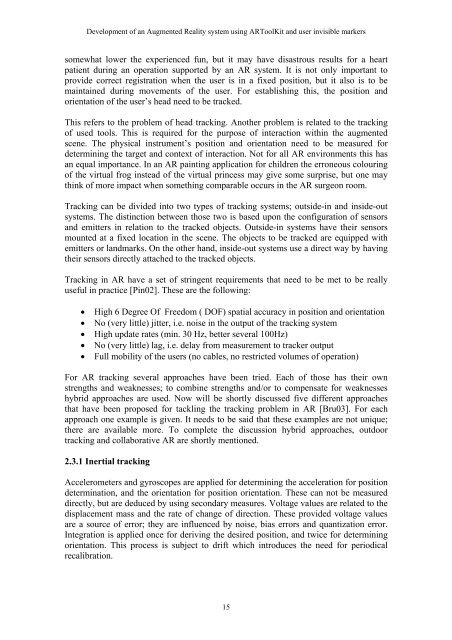Development of an Augmented Reality system using ARToolKit
Development of an Augmented Reality system using ARToolKit
Development of an Augmented Reality system using ARToolKit
Create successful ePaper yourself
Turn your PDF publications into a flip-book with our unique Google optimized e-Paper software.
<strong>Development</strong> <strong>of</strong> <strong>an</strong> <strong>Augmented</strong> <strong>Reality</strong> <strong>system</strong> <strong>using</strong> <strong>ARToolKit</strong> <strong>an</strong>d user invisible markers<br />
somewhat lower the experienced fun, but it may have disastrous results for a heart<br />
patient during <strong>an</strong> operation supported by <strong>an</strong> AR <strong>system</strong>. It is not only import<strong>an</strong>t to<br />
provide correct registration when the user is in a fixed position, but it also is to be<br />
maintained during movements <strong>of</strong> the user. For establishing this, the position <strong>an</strong>d<br />
orientation <strong>of</strong> the user’s head need to be tracked.<br />
This refers to the problem <strong>of</strong> head tracking. Another problem is related to the tracking<br />
<strong>of</strong> used tools. This is required for the purpose <strong>of</strong> interaction within the augmented<br />
scene. The physical instrument’s position <strong>an</strong>d orientation need to be measured for<br />
determining the target <strong>an</strong>d context <strong>of</strong> interaction. Not for all AR environments this has<br />
<strong>an</strong> equal import<strong>an</strong>ce. In <strong>an</strong> AR painting application for children the erroneous colouring<br />
<strong>of</strong> the virtual frog instead <strong>of</strong> the virtual princess may give some surprise, but one may<br />
think <strong>of</strong> more impact when something comparable occurs in the AR surgeon room.<br />
Tracking c<strong>an</strong> be divided into two types <strong>of</strong> tracking <strong>system</strong>s; outside-in <strong>an</strong>d inside-out<br />
<strong>system</strong>s. The distinction between those two is based upon the configuration <strong>of</strong> sensors<br />
<strong>an</strong>d emitters in relation to the tracked objects. Outside-in <strong>system</strong>s have their sensors<br />
mounted at a fixed location in the scene. The objects to be tracked are equipped with<br />
emitters or l<strong>an</strong>dmarks. On the other h<strong>an</strong>d, inside-out <strong>system</strong>s use a direct way by having<br />
their sensors directly attached to the tracked objects.<br />
Tracking in AR have a set <strong>of</strong> stringent requirements that need to be met to be really<br />
useful in practice [Pin02]. These are the following:<br />
• High 6 Degree Of Freedom ( DOF) spatial accuracy in position <strong>an</strong>d orientation<br />
• No (very little) jitter, i.e. noise in the output <strong>of</strong> the tracking <strong>system</strong><br />
• High update rates (min. 30 Hz, better several 100Hz)<br />
• No (very little) lag, i.e. delay from measurement to tracker output<br />
• Full mobility <strong>of</strong> the users (no cables, no restricted volumes <strong>of</strong> operation)<br />
For AR tracking several approaches have been tried. Each <strong>of</strong> those has their own<br />
strengths <strong>an</strong>d weaknesses; to combine strengths <strong>an</strong>d/or to compensate for weaknesses<br />
hybrid approaches are used. Now will be shortly discussed five different approaches<br />
that have been proposed for tackling the tracking problem in AR [Bru03]. For each<br />
approach one example is given. It needs to be said that these examples are not unique;<br />
there are available more. To complete the discussion hybrid approaches, outdoor<br />
tracking <strong>an</strong>d collaborative AR are shortly mentioned.<br />
2.3.1 Inertial tracking<br />
Accelerometers <strong>an</strong>d gyroscopes are applied for determining the acceleration for position<br />
determination, <strong>an</strong>d the orientation for position orientation. These c<strong>an</strong> not be measured<br />
directly, but are deduced by <strong>using</strong> secondary measures. Voltage values are related to the<br />
displacement mass <strong>an</strong>d the rate <strong>of</strong> ch<strong>an</strong>ge <strong>of</strong> direction. These provided voltage values<br />
are a source <strong>of</strong> error; they are influenced by noise, bias errors <strong>an</strong>d qu<strong>an</strong>tization error.<br />
Integration is applied once for deriving the desired position, <strong>an</strong>d twice for determining<br />
orientation. This process is subject to drift which introduces the need for periodical<br />
recalibration.<br />
15
















